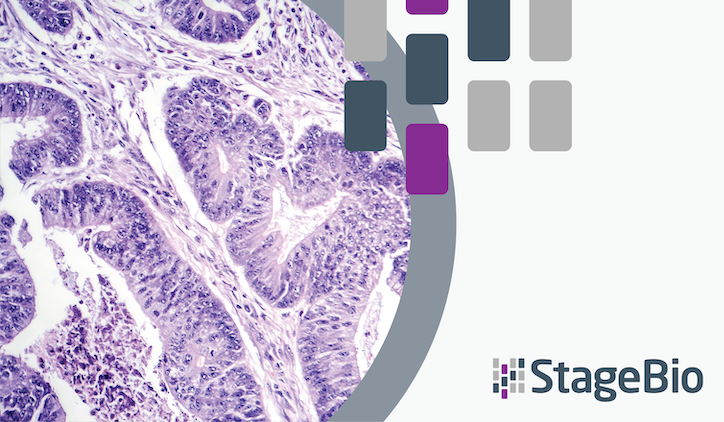Learn how StageBio uses Tissue Cross Reactivity studies (TCR) and how it helps clinical researchers when identifying off target binding.
Clinical investigators use the Tissue Cross Reactivity study (TCR) to identify the off-target binding of a therapeutic drug, antibody, or any other test biological in human or animal tissues. In other words, the TCR study helps to ensure that the test biological is not binding to any other epitopes aside from the actual target. The TCR study can also help reveal on-target binding to previously unknown sites.
TCR consists of two study phases:
1. Non-GLP method establishment and validation study
In this non-Good Laboratory Practice (non-GLP) method establishment phase, an automated or manual immunochemistry (IHC) straining protocol is developed on positive control issues known to express the target. As a negative control, an isotype antibody matching the test biologicals structure/backbone is used to check for any background or non-specific staining. This negative control is known as the control item.
If a method is established successfully, a comprehensive validation is performed to confirm reproducibility and repeatability of the staining protocol.
2. GLP-compliant study
The GLP-compliant study – the actual tissue screening study - is performed on three snap-frozen, full human tissue panels using the technically validated staining protocol. Three sections per organ are stained with:
- The test biological at a high concentration, which is pre-defined in the method establishment phase
- The test biological with an optimum concentration, also pre-defined in the method establishment phase
- The control item at the same concentrations as used for the test biological
How and where StageBio conducts TCR studies
StageBio has the technology and expertise to perform TCR studies at multiple laboratory sites allowing us to support domestic and global clients. While non-GLP method establishment and validation studies are conducted using semi-automated platforms, GLP-compliant studies are performed using fully automated staining protocols. There is a transfer of the semi-automated protocol to the fully automated protocol within the non-GLP phase, and ultimately the fully automated protocol will be validated for GLP. We can also transfer an already-developed manual staining method to our automated staining platforms.
What the TCR method requires
Test and control items
A test biological’s matching control item must be available, even if commercially. Optionally, staining with a commercially available antibody could be used to confirm the positivity of questionable staining, as well as to characterize a control system.
Additionally, test biologicals and control items must be either biotin- or FITC-conjugated. Though not necessary, a TCR study utilizing a test biological and a control item that are both biotin- and FITC-conjugated at 10 mg is recommended and preferred.
Before a TCR begins, the following questions must be answered:
- Are test biologicals and control items in GMP or non-GMP batches?
- Will a non-GMP batch be provided for the first study part and a GMP batch for the second study part?
- Will the items be conjugated by the client or by StageBio external partners?
The first two questions help determine if bridging validation is needed. Regarding the third question, we highly recommend performing a binding affinity assay conjugation, regardless of who will be conducting the conjugation.
Control tissues
A TCR requires suitable negative and positive control tissues, provided by either the client or the laboratory charged with performing the TCR.
Tissue availability
StageBio laboratories offer:
- 3 full-panel human tissue banks
- 3 full-panel tissue banks for NHP (cynomolgus monkey)
- 3 full-panel rat tissue banks
- Select tissue panels for the rhesus monkey and marmoset, mouse, and guinea pig
In StageBio’s laboratories, the complete human and NHP tissue panels are based on recommendations in Annex II of Directive 75/318/EEC, “Production and Quality Control of Monoclonal Antibodies” and in Appendix I of the 1997 US FDA/CBER “Points to Consider in the Manufacture and Testing of Monoclonal Antibody Products for Human Use”.
Evaluation
StageBio provides peer review of TCR for our clients worldwide. The following parameters are used for the TCR evaluation:
Peer review or in-house pathologist review:
- Staining distribution of every structure stained
Staining intensity of every structure stained
Type of distribution
Global score
General pathological comments
Additional services offered by StageBio
Aside from the requirements listed above, StageBio also offers:
Whole-slide imaging
TCR slides can be scanned and provided to the client through StageBio's image management system or other client-specified method. Our high-capacity whole slide scanners can scan slides at 10X, 20X, and 40X magnifications. Brightfield and multiplex fluorescence scanning capabilities (up to 6 channels) are available, at select locations, and we can scan both single (1x3) and double-width (2x3) slides.
Archiving
Archived TCR data includes:
- Study documentation (paperwork)
- Stained slides
- Aliquots from stock/diluted conjugated/unconjugated test/control items
- Positive/negative control tissues (when purchased exclusively for the study)
- Electronic data, including scanned files, are not archived.
Imaging
We can provide imaging of QC staining from fresh frozen tissues. We use Visiopharm’s Biotopix™ solution and other image analysis solutions to extract quantifiable data from your stained slides. Image analysis can be used for the following common requests, as well as many more: linear and area measurements, counting positive cells and quantification of positive staining of proteins in cells and tissues.
Have more questions about TCR or would like to learn more about StageBio?
Get in touch with us here.
